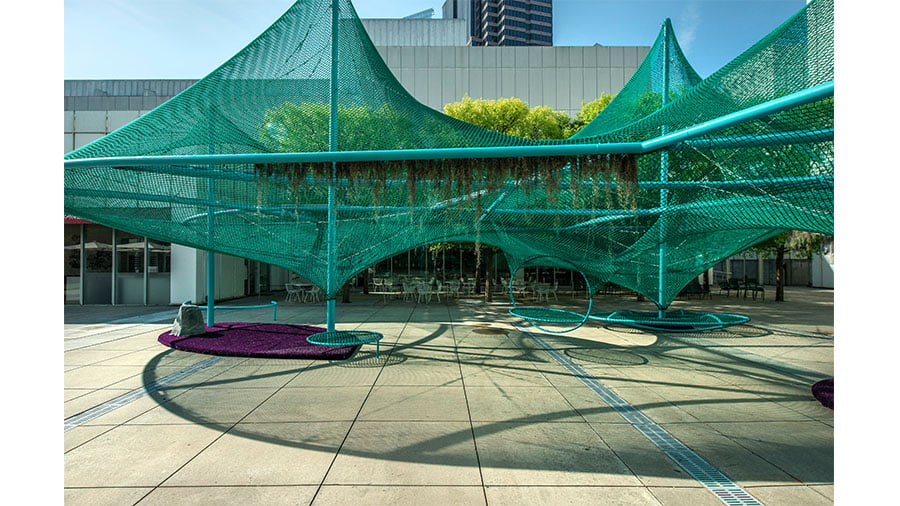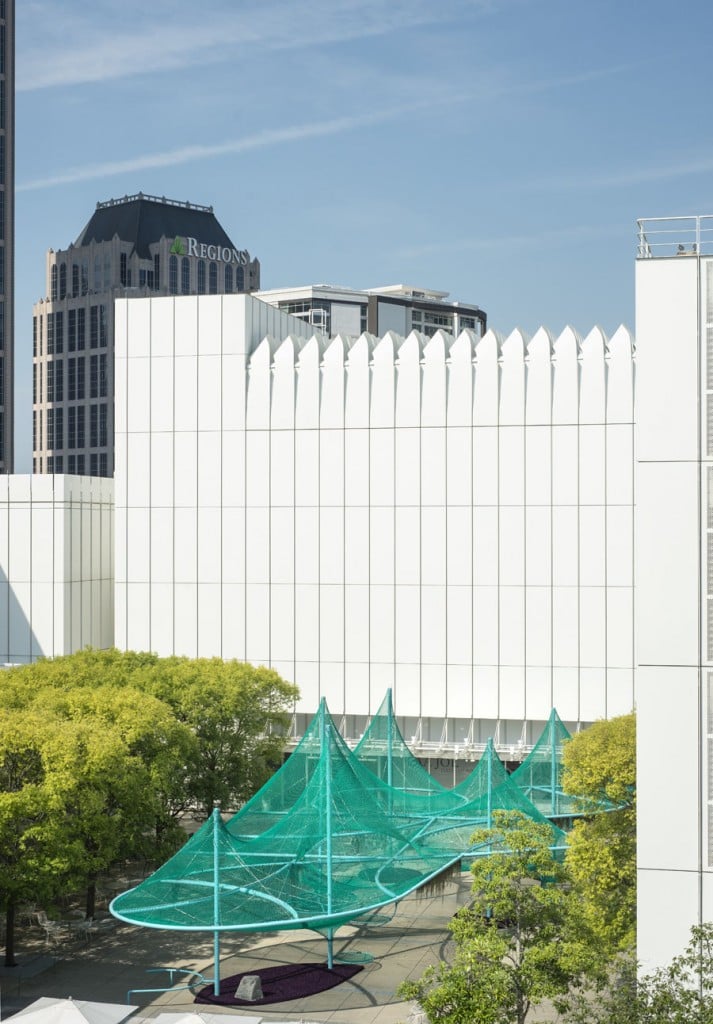
August 3, 2020
In Atlanta, “The City in a Forest,” a New Forest Emerges with Murmuration
Murmuration, a SO-IL-designed installation at the High, draws attention to how development in the city might become more porous.

Tucked in the middle of the High Museum of Art’s sleek, white, gridlike buildings in downtown Atlanta, a new installation by internationally acclaimed architecture and design firm SO-IL opened on Friday, July 17th, a day before the museum’s official reopening. Murmuration, a swooping network of structural dips and peaks accented with Spanish moss, aims to draw people and migratory birds alike by recreating the sensory elements of local tree canopies. Formed from hollow, sky blue steel poles and kelly green trapeze netting, the installation suggests a hybrid environment of futuristic construction and swampy, living foliage. The scale and shape of Murmuration’s architectural elements harmonize with the immediate skyline, falling uncannily between the neat rows of smaller, real trees that line the museum café and the austere facades of the surrounding buildings.
Suspended over the museum’s Carroll Slater Sifly Piazza, the 2,350-square-foot sculptural pavilion is the sixth in a multi-year plaza activation initiative that brings interactive and transformative design to the outdoor space for free public viewing and programming. Installations in the piazza are open to the public and share a throughline of enchanting, public-oriented design focused on interactive sensory experiences. (Past Piazza commissions include Japanese designer Yuri Suzuki’s Sonic Playground [2018], Spanish designer Jaime Hayon’s Merry Go Zoo [2017] and Tiovivo [2016)] and 2014–2015’s Mi Casa, Your Casa and Los Trompos by Mexican designers Héctor Esrawe and Ignacio Cadena.)
“We want people to experience a sense of wonder and joy in exploring the installations in this space, but it’s also very important for these projects to offer larger meanings in addition to the magic,” says Monica Obniski, the High’s curator of decorative arts and design. Live Spanish moss, a spongey, humidity-drinking, local air plant chosen for its tendency to overtake structures and soften harsh sunlight, is woven into the structure, furthering the allusion to a forest canopy. Designed to envelop guests, offer hints of shade, and provide a gathering place for both migratory birds and overheated humans, Murmuration was inspired by Atlanta’s reputation as “The City within a Forest” and the High’s proximity to the city’s largest green space, Piedmont Park. Beneath the canopy-like netting, visitors do their own kind of nesting and perching—an experience that is part big-top-tent, part city forest, and part otherworldly playground.
Designers Florian Idenburg and Jing Liu of SO-IL—who are known for their tendency toward clean lines and modern, playful structures that don’t feel rigid so much as suggestive—wanted this work to engage with the local ecosystem as much as with Atlantans. Though intended as a welcoming oasis, Murmuration is also meant to provoke dialogue about conservation by reflecting on the massive decline in bird populations from dramatic habitat changes in recent decades.
Georgia is a major stop on the Atlantic Flyway, a north-south route passage for migratory birds that begins in Greenland and follows the Atlantic coastline to the Caribbean. With Murmuration, Idenburg and Liu say that they hoped to evoke questions about who and what benefit from architecture. For whom do we build our cities? “Architecture is not nature,” the designers write in an email. “These are obviously very different experiences. But the installation attempts to respond to the very hard and closed context by offering something shaded and porous. We want it to invite conversations around how porous and welcoming our cities and institutions are to other species.” The question of human interaction with nature might be magnified even more than the designers originally intended, as pandemic precautions pushed back the springtime opening slated for April—a time when many bird species are actively migrating and roosting—to July, deep in the deadening heat of summer. There may be fewer birds, and fewer people, than originally imagined.

The challenge of creating and promoting a gathering place like Murmuration in the time of COVID-19 is not lost on the designers nor the High’s curators. To that end, the museum has peppered two-sided placards throughout the installation. One side welcomes guests to gather, providing details about the structure and concept (the name Murmuration indicates a moving, shifting flock of birds); the reverse side offers cautionary safety guidelines, asking visitors to please keep their distance, wear masks, and use the nearby hand-sanitizing stations. In addition to shifting the time schedule, the pandemic effectively cancelled any official in-person programming… for now. Obniski plans to adapt piazza programming if and when new COVID-related safety information becomes available: “Who knows what else we might learn down the road? That’s the beauty of design. It can evolve with us.”
Stay tuned to the High’s website for updates about new programming for the piazza. Murmuration will be open until November 19.
You may also enjoy “Out of a Former Cheese Factory, The Momentary Fuels a Modernist Turn in Bentonville.”
Would you like to comment on this article? Send your thoughts to: [email protected]










